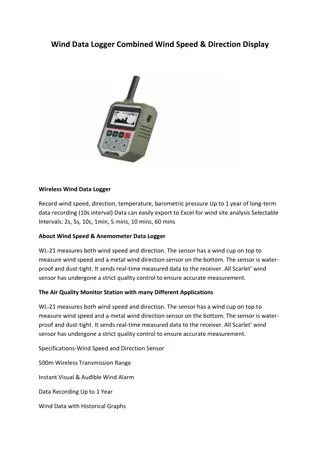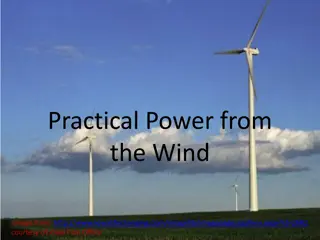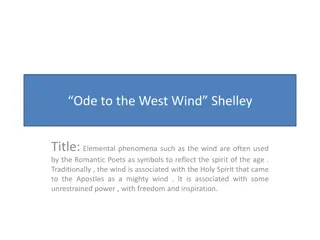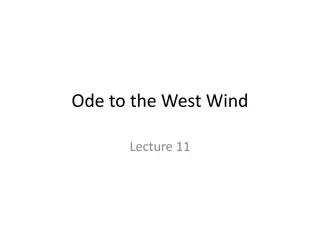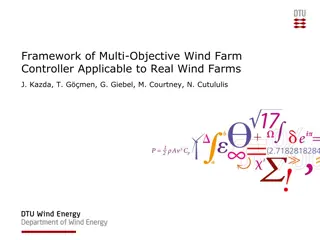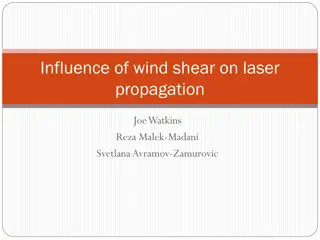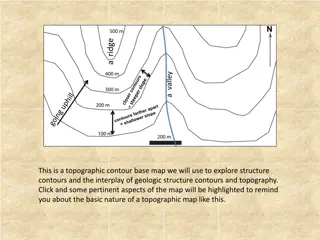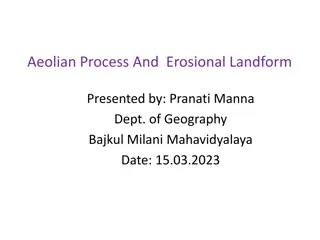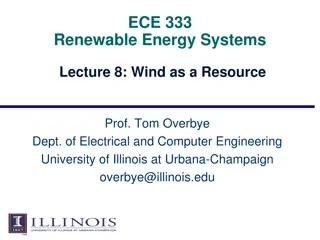Wind as a Geologic Agent in Shaping Landscapes
Wind has played a significant role in shaping landscapes during times of drier climates, being a key geologic agent impacting erosion and deposition processes. The global wind system, driven by factors such as heating from the sun and the rotation of the Earth, creates convection currents that circulate air and influence weathering in different climatic regions. This phenomenon, known as aeolian processes, is particularly prominent in arid lands like deserts. Weathering, erosion, transport, and deposition are common actions of wind in these dry regions where vegetation is scarce.
Download Presentation

Please find below an Image/Link to download the presentation.
The content on the website is provided AS IS for your information and personal use only. It may not be sold, licensed, or shared on other websites without obtaining consent from the author. Download presentation by click this link. If you encounter any issues during the download, it is possible that the publisher has removed the file from their server.
E N D
Presentation Transcript
WIND AS A GEOLOGIC AGENT Lecture 3 collectedby : Maher M Mahdi
Global wind system Wind has been important agent in shaping the landscape at times when the continents were drier and windier places than they are today. Wind is the movement of air, principally horizontal movement caused by: Heating by theSun. Rotation of Earthon its axis.
The basic reason, the atmosphere is always in motion is that more of the Sun s heat is received per unit of land surface near the equator than near the poles. This unequal heating gives rise to convection currents. The heated air near the equator becomes lighter,rises, and expands.
High up, the air spreads outward in the direction of both poles. As it gradually cools, it becomes heavier, and sinks. This cool, descending air flows back toward the equator completes a cycle of convection.
wind can be an important agent of erosion and deposition in any climate, as long as sediment particlesareloose and dry. wind differs fromrunning waterin twoways: 1. because air is less dense than water, wind can erode only fine sediment - sand, silt and clay 2. wind is not confined to channels as running water is, so wind can have a widespread effectovervastareas
Faster the air flows, more erosion Erodes more rapidly if wind blows constantly from one direction.
Geo -Aeolian processes in Arid Lands
(Aeolian process ) The common process in desert lands: weathering Wind erosion transport deposition Occurs in dry regions, with little vegetation such as deserts and coastal landscapes
Weathering The breakdown of *rocks and *minerals and below the Earth s surface by the action of physical and chemical processes. Essentially it is the response of Earth materials to the low pressures, low temperatures, and presence of air and water that characterize the near-surface environment. Not as effective as in humid regions Mechanical weathering unaltered rock and mineral fragments Clay Thin soils Oxidized minerals produces
Wind Erosion Two forms of wind erosion The First: Deflation or desert pavement The removal of material from a land surface by *aeolianprocesses. It is most effective where extensive unconsolidated materials are exposed, *Removal of material by wind *transport
Abrasion results Ventifacts or Dreikanters A pebble that has been faceted by the abrasive action of wind-blown sand and dust. Multiple faceting may reflect pebble movement as underlying sand is disturbed,rather than changes in wind direction. Each facet faces the direction of the abrading wind. A pebble with three facets (triangular facet) is called a dreikanter ; one with one facet an einkanter Polishing, Blowout - area deflated by wind Streamlining (Yardangs) On Mars, with billions of years of only wind erosion, wind has had much greater effects
Abrasion airborne particles chip off small fragments of other rocks.
Transportation of sediment by wind Differs from that of running water in two ways 1.Wind is less capable of picking up and transporting coarse materials . 2. Wind is not confined to channels and can spread sediment over large areas
Sediment Transport Wind is not as effective at moving particles as is water Viscosity of air is 17.6 * 10-3mPa-s Viscosity of water is 1 mPa-s Wind must overcome resisting forces Weight of grains Cohesion between grains
Mechanisms of wind blown grains Geologists usually define rock particles by their size in diameter measured in millimeters, from the largest at 2.0 millimeters to the smallest, at 0.1 millimeters 1. Saltation skipping and bouncing along the surface. About 20 to 25 % of the sand transported in a sandstorm is moved this way. 2.Creep or rolling When the largest sized particles can not picked up by the wind. However, the strikes by smaller particles energy thereby moving them forward transfer
3.Suspended load as clouds of fine, dustlike particles that can rise to altitudes of more than 2 meters (6,560 ft.). In particularly volatile conditions suspended sand particles can result in sandstorms Wind transportation mechanisms
Sediment size blown by the wind depends on wind speed: In exceptional wind storms, when wind speeds locally reach 300 km/h or more, coarse rock particles up to several centimeters in diameter can be lifted to height of a meter or more. In moist regions, where wind speed rarely exceeds 50 km/h, the largest particles of sediment that can be suspended in the air stream are grains of sand.
At lower wind speeds, sand moves along close to the ground surface, and only finer grains of dust move in suspension. If a wind blows across a bed of sand, the grains begin to move when the wind speed reaches about 4.5 m/s (16 km/h).
With increasing wind speed, turbulence lifts moving sand grains into the air: this is saltation. Saltation accounts for at least three- quarters of the sand transport in areas coveredbysanddunes. Sheets of well-sorted sand that have accumulated on the land surface are unstable.
Saltation moves the smaller, most easily transported grains. Sand grains too large to be moved are left behind. The coarse grains form a series of small, linear ridges of sand called sand ripples.


